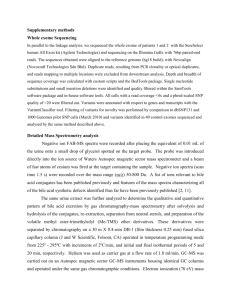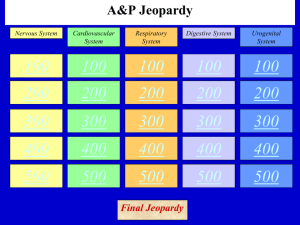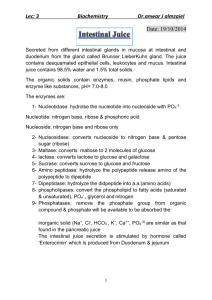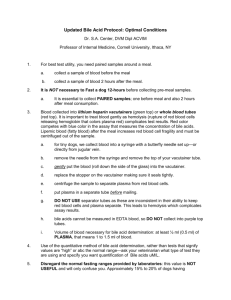Disorders of Bile Acid Synthesis 32
advertisement
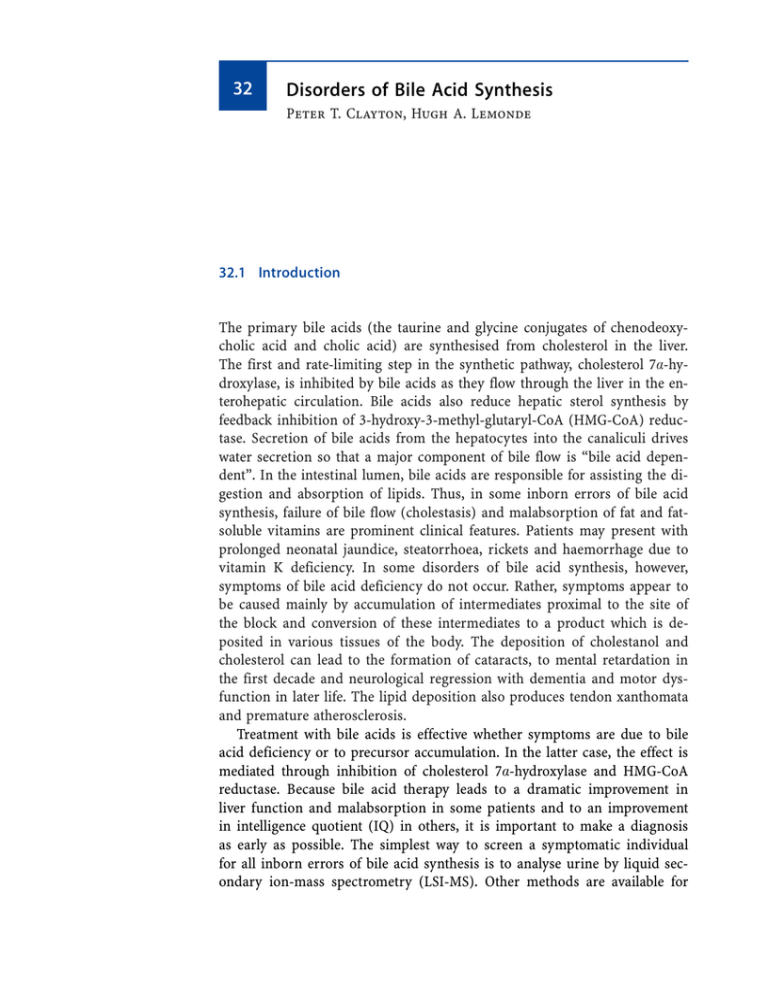
32 Disorders of Bile Acid Synthesis Peter T. Clayton, Hugh A. Lemonde 32.1 Introduction The primary bile acids (the taurine and glycine conjugates of chenodeoxycholic acid and cholic acid) are synthesised from cholesterol in the liver. The first and rate-limiting step in the synthetic pathway, cholesterol 7a-hydroxylase, is inhibited by bile acids as they flow through the liver in the enterohepatic circulation. Bile acids also reduce hepatic sterol synthesis by feedback inhibition of 3-hydroxy-3-methyl-glutaryl-CoA (HMG-CoA) reductase. Secretion of bile acids from the hepatocytes into the canaliculi drives water secretion so that a major component of bile flow is “bile acid dependent”. In the intestinal lumen, bile acids are responsible for assisting the digestion and absorption of lipids. Thus, in some inborn errors of bile acid synthesis, failure of bile flow (cholestasis) and malabsorption of fat and fatsoluble vitamins are prominent clinical features. Patients may present with prolonged neonatal jaundice, steatorrhoea, rickets and haemorrhage due to vitamin K deficiency. In some disorders of bile acid synthesis, however, symptoms of bile acid deficiency do not occur. Rather, symptoms appear to be caused mainly by accumulation of intermediates proximal to the site of the block and conversion of these intermediates to a product which is deposited in various tissues of the body. The deposition of cholestanol and cholesterol can lead to the formation of cataracts, to mental retardation in the first decade and neurological regression with dementia and motor dysfunction in later life. The lipid deposition also produces tendon xanthomata and premature atherosclerosis. Treatment with bile acids is effective whether symptoms are due to bile acid deficiency or to precursor accumulation. In the latter case, the effect is mediated through inhibition of cholesterol 7a-hydroxylase and HMG-CoA reductase. Because bile acid therapy leads to a dramatic improvement in liver function and malabsorption in some patients and to an improvement in intelligence quotient (IQ) in others, it is important to make a diagnosis as early as possible. The simplest way to screen a symptomatic individual for all inborn errors of bile acid synthesis is to analyse urine by liquid secondary ion-mass spectrometry (LSI-MS). Other methods are available for 616 Disorders of Bile Acid Synthesis some of the individual disorders. Routine neonatal screening has not yet been described. In disorders which affect cholesterol synthesis (e.g, mevalonic aciduria, 7-dehydrocholesterol reductase deficiency [Smith-Lemli-Opitz syndrome]) there may be markedly reduced bile acid synthesis – these disorders are beyond the scope of his chapter. As indicated in section 3, the synthesis of bile acids involves conversion of C27 bile acids (cholestanoic acids) to their C24 analogues (cholanic acids) and this occurs by a process of b-oxidation in the peroxisomes. Thus defective bile acid synthesis occurs in disorders of peroxisomal b-oxidation and in disorders of peroxisome biogenesis. These disorders affect pathways other than the bile acid synthesis pathway and are discussed in Chap. 23. 32.2 Nomenclature Disorder Affected component Tissue distribution Chromosomal MIM localisation 32.1 3b-Hydroxy-D5-C27-steroid dehydrogenase (3b-HSDH) deficiency D4-3-Oxosteroid 5b-reductase deficiency (5b-reductase deficiency) Sterol 27-hydroxylase deficiency (cerebrotendinous xanthomatosis, CTX) Oxysterol 7a-hydroxylase (CYP7b) deficiency Fibroblasts 16p11.2–12 231100 Liver 7q31 235555 Fibroblasts 2q33-qter 213700 Fibroblasts 8q21.3 231100 32.2 32.3 32.4 Metabolic Pathway 617 32.3 Metabolic Pathway Fig. 32.1. The classical (‘neutral’) pathway for the synthesis of bile acids from cholesterol, where the modification of the steroid nucleus occurs prior to side-chain modification. Also illustrated are the inborn errors of bile acid synthesis and the resulting abnormal metabolites. 32.1, 3b-hydroxy-D5-C27-steroid dehydrogenase (3b-HSDH) deficiency; 32.2, D4-3-oxosteroid 5b-reductase deficiency; 32.3, sterol 27-hydroxylase deficiency (cerebrotendinous xanthomatosis, CTX); PD, peroxisomal disorders (defects of peroxisome biogenesis and peroxisomal b-oxidation). The abnormal metabolites that are readily detected by analysis of urine by LSI-MS are shown in boxes. Cholic acid can also be synthesised from 5b-cholestane-3a,7a,12a,25-tetrol; this is the so-called microsomal or 25-hydroxylase pathway of cholic acid synthesis, which provides an alternative route for side-chain modification other than peroxisomal b-oxidation 618 Disorders of Bile Acid Synthesis Fig. 32.2. The alternative (‘acidic’) pathway for the synthesis of bile acids, which starts with conversion of cholesterol to 27-hydroxycholesterol and results predominantly in the production of chenodeoxycholic acid. Also shown is the route of the classical pathway via 7a-hydroxycholesterol. The alternative pathway illustrates that side-chain modification can proceed modification of the steroid nucleus, although the exact sequence and relative contributions of these different pathways is unclear, with most of the synthetic enzymes being shared by both pathways. A deficiency of oxysterol 7a-hydroxylase (32.4), which is unique to the alternative pathway, is shown, and the abnormal metabolites that are readily detected in urine by LSI-MS are highlighted Signs and Symptoms 619 32.4 Signs and Symptoms Table 32.1. 3b-Hydroxy-D5-C27-steroid dehydrogenase deficiency System Symptoms/marker Neonatal Infancy Childhood Characteristic clinical findings Jaundice Steatorrhoea Rickets Vit. K-reponsive bleeding Pruritus Conjugated bilirubin (P) ASAT/ALAT (P) c-GT (P) Alkaline phosphatase (P) Albumin (P) Calcium (P) Cholesterol (P) Prothrombin ratio Periportal inflammation Giant cells Cholestasis Bridging fibrosis Cirrhosis Sulfated 3b,7a-dihydroxyand 3b,7a,12a-trihydroxy-5cholenoic acids (P, U) (m/z 469, 485, 526, 542 on LSIMS) Vitamin A (P) 25-Hydroxy-vitamin D (P) Vitamin E (P) Chenodeoxycholic acid (P) Negative ion LSI-MS (U) (m/z 469, 485, 526, 542) + + + ± ± + + ± ± n–: : n : n ;–n ;–n n–: + + ± + + ± ± n–: : n : n ;–n ;–n n–: + + ± + ± + ;–n ; ; ; + ;–n ; ; ; + ;–n ; ; ; + Routine laboratory Liver biopsy Special laboratory : : n : n ;–n ;–n n–: + + + ± + ± + 620 Disorders of Bile Acid Synthesis Table 32.2. D4-3-Oxosteroid 5b-reductase deficiency a System Characteristic clinical findings Symptoms/markers Jaundice Hepatosplenomegaly Ascites, edema Routine laboratory Conjugated bilirubin (P) ASAT/ALAT (P) c-GT (P) Alkaline phosphatase (P) Albumin (P) Cholesterol (P) Prothrombin ratio Ferritin (S) Liver biopsy Periportal and lobular inflammation Giant cells Cholestasis Pseudoacinar transformation Small caniculi, few microvilli Special laboratory 7a-Hydroxy-3-oxo- and 7a,12a-dihydroxy3-oxo-4-cholenoic acids (U) (m/z 444, 460, 494, 510 on LSI-MS) Tyrosine, methionine (P) Allocholic and allochenodeoxycholic acid (P) Reduced content of immunoreactive 5b-reductase in liver biopsy/truncated protein a Neonatal Infancy + ± ± : : n–: n–: ;–n ;–n : n-: ± + + + + + ± ± ± n–: : n–: n-: ;–n ;–n n–: n–: ± + + ± ± + : + n–: + + + There is no test currently available that can prove that a patient has reduced activity D4-3-oxosteroid 5b-reductase as a result of a defect in the gene coding for this enzyme and it is known that reduced activity of the enzyme (resulting in excretion of 3-oxo-D4 bile acids) can occur as a non-specific consequence of severe liver damage in infancy/ childhood. Thus, at present the features of 5b-reductase deficiency cannot be accurately defined. Nor can its relationship to other recessive disorders causing severe liver damage (e.g. neonatal haemochromatosis). Signs and Symptoms Table 32.3. Sterol 27-Hydroxylase deficiency (Cerebrotendinous xanthomatosis, CTX) System Symptoms/marker Developmental delay/;IQ Regression/dementia Spastic paresis/pyramidal signs Ataxia Expressive dysphasia Tendon xanthomatoma Ischaemic heart disease, angina/ myocardial infarction Cataracts Spinal cord myelopathy Routine laboratory Cholesterol (P) Special laboratory Cholestane pentol glucuronides (U) (m/z 627 in LSI-MS) 25-Hydroxy-vitamin D (P) Abnormal EEG ± evoked potentials Cholestanol (P) 27-Hydroxylase (FB) GI Diarrhoea Respiratory Failure CNS Peripheral neuropathy Parkinsonian symptoms, hypokinesia/tremor Demyelination and lipid deposition on MRI Convulsions Endocrine Hypo-/hyperthyroidism Adrenal insufficiency Pituitary/hypothalamic dysfunction Musculoskeletal Fractures (osteoporosis) Foot deformity (pes cavus) Hepatobiliary Pigment granules in liver biopsy Gall stones/cholecystectomy Neonatal Infancy Characteristic clinical findings Childhood Adolescence Adult ± ± ± ± ± ± ± ± ± ± ± ± ± ± ± ± + n–: + ± ± n–: + ± ;–n ± ;–n ± : ; : ; ± + : ; + : ; ± : ; ± ± ± ± ± ± ± ± ± ± ± ± ± ± ± 621 622 Disorders of Bile Acid Synthesis Table 32.4. Oxysterol 7a-hydroxylase deficiency System Symptoms/marker Infancy a Characteristic clinical findings Jaundice Hepatosplenomegaly Vit. K-responsive bleeding Total/direct bilirubin (S) ALAT/ASAT (S) c-GT (S) Alkaline phosphatase (S) Prothrombin time Cholesterol (S) Cholestasis Portal inflammation/lobular disarray Bridging fibrosis Giant cells Bile duct proliferation 3b-Hydroxy-5-cholenoic acids (U) (m/z 453, 510 by LSI-MS) Vitamin E (S) Retinol (S) + + + : : n : : n + + + + + + Routine laboratory Liver biopsy Special laboratory a n ; Taken from the case report of a single patient. 32.5 Reference Values n Determination of Urinary Cholanoid (Bile Acid and Bile Alcohol) Profile by LSI-MS The mass spectrometer scans negative ions over the range m/z 350–700 and draws a spectrum with the largest peak as 100% intensity. In the following table, – indicates that the peak is not detectable above the background, ± indicates undetectable to 20% of the largest peak, : indicates 20–100% intensity of largest peak. Reference Values 623 Ion Identity Normal Cholestasis 444 448 7a-Hydroxy-3-oxo-4-cholenoic acid (Gly) Dihydroxy-cholanoic acids (e.g. chenodeoxycholic acid) (Gly) 3b-Hydroxy-5-cholenoic acid (SO4) 7a,12a-Dihydroxy-3-oxo-4-cholenoic acid (Gly) Trihydroxy-cholanoic acids (e.g. cholic acid) (Gly) 3a,7a-Dihydroxy-5-cholenoic acid (SO4) also steroid sulphatea 3a,7a,12a-Trihydroxy-5-cholenoic acid (SO4) 7a-Hydroxy-3-oxo-4-cholenoic acid (Tau) Dihydroxy-cholanoic acids (e.g. chenodeoxycholic acid) (Tau) 7a,12a-Dihydroxy-3-oxo-4-cholenoic acid (Tau), 3a-Hydroxy-5-cholenoic acid (Gly, SO4) Trihydroxy-cholanoic acids (e.g. cholic acid) (Tau) 3a,7a-Dihydroxy-5-cholenoic acid (Gly, SO4) Dihydroxy-cholanoic acids (e.g. chenodeoxycholic acid) (Gly, SO4) Tetrahydroxy-cholanoic acids (Tau) 3a,7a,12a-Tihydroxy-5-cholenoic acid (Gly, SO4) Tetrahydroxycholestanoic acids (Tau) 27-Nor-cholestanepentol (SO4) (Gluc) Cholestanepentols (Gluc) – ± ± ±/: – – ± – ± – – ± ± ± ±/: – – – ± ±/: ± ± ± – ± ±/: ± ±/: ± – – ± ± ±/: – – ± ± 453 460 464 469 485 494 498 510 514 526 528 530 542 572 613 627 Gly, glycine conjugate; Tau, taurine conjugate; SO4, sulphate; Gluc, glucuronide a An ion of mass/charge ratio 469 can occur in urine samples from patients who do not have 3b-HSDH deficiency; the other ions which are characteristic of 3b-HSDH (485, 526, 542) are not present and GC-MS fails to show increased excretion of 3a,7a-dihydroxy-5-cholenoic acid. n Urinary Cholanoid Excretions Determined by GC-MS Cholanoid lmol/mmol Creat % Total bile acid excretion 3b,7a-diOH-5-cholenoic acid a 3b,7a,12a-triOH-5-cholenoic acid a 7a-OH-3-oxo-4-cholenoic acid b 7a,12a-triOH-3-oxo-4-cholenoic acid b Cholestanepentols c <0.1 <0.1 trace d trace d <1.0 <2% <2% a d d Following mild solvolysis and enzymatic hydrolysis of glycine conjugates. Following enzymatic hydrolysis of glycine and taurine conjugates. c Following hydrolysis with glucuronidase. d Amount of urinary bile acids in healthy neonates, including 3-oxo-D4 bile acids, has been shown to be elevated in the first month of life – 7a,12a-diOH-3-oxo-cholenoic acid <13.0 lmol/mmol creat (<30% total bile acid excretion) and 7a-OH-3-oxo-cholenoic acid <0.4 lmol/mmol creat (<1% total bile acid excretion). See ref. [14]. b 624 Disorders of Bile Acid Synthesis n Plasma Cholanoid Concentrations The data below refers to results obtained by GC-MS following hydrolysis of glycine and taurine conjugates with cholylglycine hydrolase. Normal plasma bile acid concentrations are higher in the postprandial period (0.5–3 h following a fat-containing meal) than in the fasting state. They are also higher in the neonatal period than later in infancy. For the purposes of diagnosis of inborn errors these differences are not of great importance and have not been included in the reference data. Plasma cholanoid Concentration (lmol/l) Chenodeoxycholic acid Cholic acid Other cholanoids of diagnostic significancea Normal Cholestatic 0.22–12.4 0.05–4.55 <0.25 25–359 7–317 <0.25 a 3b,7a-Dihydroxy-5-cholenoic, 3b,7a,12a-trihydroxy-5-cholenoic, 7a-hydroxy-3-oxo-4cholenoic, 7a,12a-diOH-3-oxo-4-cholenoic, allocholic, allochenodeoxycholic and 3a,7a,12a-trihydroxy-5b-cholestanoic acid (THCA). n Plasma Cholestanol Concentrations The values below refer to total plasma cholestanol concentration determined by GC-MS analysis following hydrolysis of cholestanol esters. Age <15 y >15 y Cholestatic Cholestanol (P) (lmol/l) 1–9 4–18 4–50 Pathological Values 625 32.6 Pathological Values n Urinary Cholanoid (Bile Acid and Alcohol) Profile by LSI-MS Ion Identity 444 448 7a-Hydroxy-3-oxo-4-cholenoic acid (Gly) Dihydroxy-cholanoic acids (e.g. chenodeoxycholic acid) (Gly) 3b-Hydroxy-5-cholenoic acid (SO4) 7a,12a-Dihydroxy-3-oxo-4-cholenoic acid (Gly) Trihydroxy-cholanoic acids (e.g. cholic acid) (Gly) 3b,7a-Dihydroxy-5-cholenoic acid (SO4) also steroid sulphate? 3b,7a,12a-Trihydroxy-5-cholenoic acid (SO4) 7a-Hydroxy-3-oxo-4-cholenoic acid (Tau) Dihydroxy-cholanoic acids (e.g. chenodeoxycholic acid) (Tau) 7a,12a-Dihydroxy-3-oxo-4-cholenoic acid (Tau) or 3b-Hydroxy-5-cholenoic acid (Gly, SO4) Trihydroxy-cholanoic acids (e.g. cholic acid) (Tau) 3b,7a-Dihydroxy-5-cholenoic acid (Gly, SO4) Dihydroxy-cholanoic acids (e.g. chenodeoxycholic acid) (Gly, SO4) Tetrahydroxy-cholanoic acids (Tau) 3b,7a,12a-Tihydroxy-5-cholenoic acid (Gly, SO4) Tetrahydroxycholestanoic acids (Tau) 27-Nor-cholestanepentol(s) (Gluc) Cholestanepentols (Gluc) 453 460 464 469 485 494 498 510 514 526 528 530 542 572 613 627 a 32.1 32.2 5b32.3 Sterol 27- 32.4 Oxysterol Peroxisomal 3b-HSDH Reductase a hydroxylase 7a-hydroxydisorders (CTX) lase : –/± ± : : –/± ± : –/± ± : : : : –/± ± : ± ± : : :c ±/: b In patients considered to have a genetic deficiency of 5b-reductase, the LSI-MS spectrum shows peaks due to 3-oxoD4 bile acids that are 4–5 times larger than those due to the corresponding saturated bile acids ie 444 ? 448, 460 ? 464, 494 ? 498, 514 ? 510. The saturated bile acids may not be detectable above the background. By contrast a LSI-MS spectrum which shows 3-oxo-D4 peaks of similar size to the corresponding saturated bile acid i.e. 444 approx.= 448 etc. indicates severe hepatocyte damage due to something other than genetic 5b-reductase deficiency. In these patients the excretion of 3-oxo-D4 bile acids will disappear when the hepatocyte function improves. b In patients with peroxisome biogenesis defect over the age of 18 mo the LSI-MS analysis may give a negative result. c Also observed in a patient postulated to have an inborn error of the 25-hydroxylase pathway for bile acid side-chain synthesis (along with a large m/z 611 – cholestanetetrol glucuronides), who presented with neonatal jaundice and hepatomegaly (see ref. [11]). 626 Disorders of Bile Acid Synthesis n Further Analysis of Urinary Cholanoid Profile by GC-MS GC-MS analysis is used to confirm the identities of ions in the LSI-MS urine spectrum and show that the excretion of abnormal cholanoids is >20 times normal. In the case of 5b-reductase deficiency GC-MS analysis should show that 3-oxo-D4 bile acids account for >70% of the total urinary bile acid excretion. In the case of sterol 27-hydroxylase deficiency (CTX), GC-MS analysis should indicate that the major cholestane pentols in the urine are 3,7,12,22,25 and 3,7,12,23,25-pentols. (One patient has been described who had familial cholestatic liver disease associated with greatly increased urinary excretion of 5b-cholestane-3a,7a,12a,24 S,25-pentol [see previous table]). Liquid secondary ion-tandem mass spectrometry (LSI-MS/ MS) is an alternative method to GC-MS and can rapidly confirm the identity of a number of diagnostic ions that are found in the LSI-MS spectrum of urine. These include sulphated and taurine-conjugated abnormal metabolites such as those observed in 3b-HSDH deficiency (32.1), 5b-reductase deficiency (32.2), oxysterol 7a-hydroxylase deficiency (32.4) and peroxisomal disorders [13]. Plasma cholanoids (lmol/l) 32.1 3bHSDH Chenodeoxycholic acid Cholic acid 3b,7a-Dihydroxy-5-cholenoic a 3b,7a,12a-Trihydroxy-5-cholenoic a ; (<0.1) :/; (0–25) ; n/;(0–4.5) n/; n/; :: (1–80) : (0.05– 30) :: (3–40) :(0.8–10.0)b :(0.3–2.0)b :(0.5–10.0)c :(0.5–8.0)c 3b,7a-Dihydroxy-5-cholestenoic 7a-Hydroxy-3-oxo-4-cholenoic 7a,12a-Dihydroxy-3-oxo-4-cholenoic Allochenodeoxycholic acid Allocholic acid 3b-Hydroxy-5-cholenoic acid 3b-Hydroxy-5-cholestenoic acid 3a,7a-Dihydroxycholestanoic acid 3a,7a,12a-Trihydroxycholestanoic acid 5b-Cholestane-3a,7a,12a,25-tetrol Other compounds detected in cholanoid profile Cholestanol a 32.2 5bReductase 32.3 Sterol 32.4 Oxysterol Peroxisomal 27-hydroxylase 7a-hydroxylase disorders (CTX) :: d n n :: (87) :: (24) n/: n/; :: (0.5–12) :: (0.8–30) e : (19–400) These compounds are present almost entirely as sulphates in the plasma of patients with 3b-HSDH deficiency and will not be detected unless plasma is subjected to a mild solvolysis procedure. b 3-Oxo-D4-bile acids constitute >10% of total plasma bile acids. c Allo-bile acids constitute >20% of total. d 7a-Hydroxycholesterol, 7a-hydroxy-cholest-4-en-3-one, 7a,12a-dihydroxy-cholest-4-en-3-one, 5b-cholestane-3a,7a,12atriol. e C29-dicarboxylic acid and tetrahydroxycholestanoic acids in disorders of peroxisome biogenesis. Varanic acid in disorders of D-bifunctional protein and thiolase deficiencies. Diagnostic Flow Chart 32.7 Loading Tests Not applicable. 32.8 Diagnostic Flow Chart Fig. 32.3 627 628 Disorders of Bile Acid Synthesis 32.9 Specimen Collection Test Conditions Urine cholanoid No bile acid profile by LSI- therapy MS Material Urine ³ 0.5 ml Ambient temp. 12 h, 4 8C for 48 h, –20 8C for >6 months Ambient temp. 48 h Further analysis of urinary cholanoids by GC-MS Plasma bile acids No bile acid therapy Cholanoids from urine adsorbed on C18 cartridge (volume of urine and creatinine recorded) Urine ³2.0 ml (can be sent on C18 cartridge as above) Plasma/serum 0.5–2.0 ml Plasma cholestanol No bile acid therapy Plasma/serum 0.2–1.0 ml No bile acid therapy Handling Pitfalls Drugs and radiographic contrast media may produce large peaks on the LSI-MS spectrum As above Ambient temp. 12 h, 4 8C for 48 h, -20 8C for >6 months As above 32.10 Prenatal Diagnosis 32.1 3b-Hydroxy-D5-C27-steroid dehydrogenase deficiency: Prenatal diagnosis has not been recorded but the enzyme can be assayed in cultured skin fibroblasts and could probably therefore be assayed in chorionic villus cells or amniocytes. 32.2 D4-3-oxosteroid 5b-reductase: Mutation screening of the 5b-reductase gene is likely to be available soon. 32.3 Sterol 27-hydroxylase deficiency (CTX): This enzyme deficiency is also detectable in cultured fibroblasts. In addition DNA-based methods could be used for the detection of common mutations. 32.4 Oxysterol 7a-hydroxylase: Gene analysis has been conducted on the sole patient described with this disorder. References 629 32.11 Initial Treatment Infants with severe cholestasis due to 3b-HSDH deficiency may have hypocalcaemia due to malabsorption of vitamin D or severely deranged clotting due to malabsorption of vitamin K. Vitamins D and K should be given either parenterally or orally in a form that is absorbed despite intestinal bile salt deficiency (e.g. 1a-hydroxy-cholecalciferol or 1,25-dihydroxy-cholecalciferol). Fresh frozen plasma and intravenous calcium supplement may occasionally be required. 32.12 Summary/Comments Diagnosis of the 4 inborn errors of bile acid synthesis discussed in this chapter is important because three are treatable by oral bile acid supplementation (such treatment was not successful in the single reported case of oxysterol 7a-hydroxylase deficiency). Liquid secondary ion mass spectrometry (LSI-MS) is a simple and rapid method which can be used to screen urine samples for abnormal cholanoids (bile acids and bile alchohols). It should be applied to neonates with unexplained cholestatic liver disease, particularly if familial and associated with steatorrhoea and fat-soluble vitamin malabsorption, to infants and children with developmental delay whether or not this is associated with specific features suggestive of a peroxisomal disorder (e.g. hypotonia, seizures, dysmorphic features, ocular and auditory abnormalities and hepatic dysfunction) or CTX (e.g. juvenile cataracts). References 1. Björkhem I. Mechanism of bile acid biosynthesis in mammalian liver. In: Danielsson H & Sjövall J (eds) Sterols and Bile Acids. New Comprehensive Biochemistry Volume 12. 1985. Elsevier, Amsterdam, New York, Oxford, pp 231–278 2. Clayton PT. Inborn errors of bile acid metabolism. J Inher Metab Dis 1991 14: 478– 496 3. Russell DW & Setchell KDR. Bile acid biosynthesis. Biochemistry 1992 31: 4737–4749 4 .Verrips A, Hoefsloot L, Steenbergen G, Theelan J, Wevers R et al. Clinical and molecular characteristics of patients with cerebrotendinous xanthomatosis Brain (2000) 123: 908–919 5. Kuriyama M, Fujiyama J, Yoshidome H, Takenaga S, Matsumoro K, Kasama T, Fukada K, Kuramoto T, Hoshita T, Seyama Y et al. Cerebrotendinous xanthomatosis: clinical features of eight patients and a review of the literature. J Neurol Sci (1991) 102: 225–232 6. Berginer VM, Shany S, Alkalay D, Berginer J, Dekel S, Salen G, Tint GS & Gazit D. Osteoporosis and increased bone fractures in cerebrotendinous xanthomatosis. Metabolism 1993, 42: 69–74 630 Disorders of Bile Acid Synthesis 7. Bjorkhem I, Boberg KM. Inborn errors in bile acid biosynthesis and storage of sterols other than cholesterol. In: Scriver CR, Beaudet AL, Sly WS, Valle D, eds. The Metabolic and Molecular Basis of Inherited Disease. McGraw-Hill, 1995: 2073–2101 8. Clayton PT. Delta 4-3-oxosteroid 5 beta-reductase deficiency and neonatal hemochromatosis [letter; comment]. J Pediatr 1994, 125: 845–846 9. Shneider BL, Setchell KD, Whitington PF, Neilson KA, Suchy FJ. Delta 4-3-oxosteroid 5 beta-reductase deficiency causing neonatal liver failure and hemochromatosis [see comments]. J Pediatr 1994; 124: 234–238 10. Leitersdorf E, Reshef A, Meiner V et al. Frameshift and splice-junction mutations in the sterol 27-hydroxylase gene cause cerebrotendinous xanthomatosis in Jews of Moroccan origin. J. Clin. Invest. 1993, 91, 2488–2496 11. Clayton PT, Casteels M, Mieli Vergani G, Lawson AM. Familial giant cell hepatitis with low bile acid concentrations and increased urinary excretion of specific bile alcohols: a new inborn error of bile acid synthesis? Pediatr Res 1995, 37: 424–431 12. Setchell KD, Schwarz M, O’Connell NC et al. Identification of a new inborn error in bile acid synthesis: mutation of the oxysterol 7alpha-hydroxylase gene causes severe neonatal liver disease. J Clin Invest 1998, 102: 1690–1703 13. Lemonde HA, Johnson AW, Clayton PT. Identification of unusual bile acid metabolites by tandem mass spectrometry: use of low energy collision induced dissociation to produce informative spectra Rapid Commun Mass Spectrom 1999, 13(12):1159–64. 14. Kimura A, Mahara R, Inoue T, et al. Profile of urinary bile acids in infants and children: developmental pattern of excretion of unsaturated ketonic bile acids and 7bhydroxylated bile acids. Ped Res (1999) 45(4): 603–609 15. Schwarz M, Wright A, Davies D, et al. The bile acid synthetic gene 3b-hydroxy-D5C27-steroid oxido-reductase is mutated in progessive intrahepatic cholestasis. J Clin Invest (2000) 106: 1175–1184


